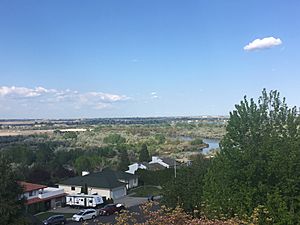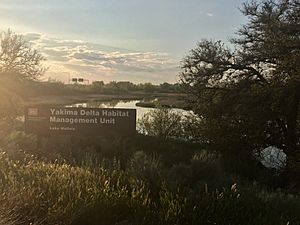Yakima River Delta facts for kids
The Yakima River Delta is a special piece of land in Richland, Washington. It's where the Yakima River flows into the much larger Columbia River. This area is mostly a floodplain, which means it's flat land near a river that can sometimes flood. It has many plants that grow near water, like Russian olive trees. A smaller stream called Amon Creek also joins the Yakima River here.
People love to visit the delta for fun activities. You can go kayaking on the water or hike on the trails. The Sacagawea Heritage Trail, a bike path, goes through the delta. This trail connects the three cities of the Tri-Cities. The delta is generally bordered by Columbia Park Trail to the south. Interstate 182 is to its north.
Contents
Protected Areas of the Yakima Delta
Most of the Yakima River Delta is part of protected areas. These areas help keep the land and animals safe. The south side of the Yakima River is one such place. It is part of the Yakima Delta Wildlife Management Unit. The U.S. Army Corps of Engineers owns this unit. It covers about 300 acres (121 hectares) of land. A part of the delta south of Columbia Point is also in this unit.
North of the river, there is another protected spot. This is the Chamna Natural Preserve. It covers about 276 acres (112 hectares). The city owns this preserve. The Tapteal Greenway group helps take care of it. Chamna has about 11 miles (18 kilometers) of hiking trails. Signs along the trails tell visitors about the plants and animals. Chamna was the name of a nearby Native American village.
Both the Wildlife Management Unit and Chamna are for day use only. This means you can visit during the day. Camping and hunting are not allowed in these areas.
Wildlife and Plants of the Delta
Even though the area is dry, the delta is home to many different plants and animals. Many kinds of birds visit the delta. You might see unusual birds like the marbled godwit or the red phalarope. Salmon are also very important fish in the delta's waters. The water levels are controlled by the McNary Dam near Umatilla, Oregon.
The delta has thick forests near the water. Next to these forests are plants that grow in the desert. This mix means the area can easily catch fire. A large wildfire happened here in 2011. Today, too many people using the area can harm it. Also, plants that are not native to the area can cause problems.
Helping the Delta's Environment
Many groups are working to make the delta healthier. They are also planning more projects for the future. The Benton County Conservation District helps control invasive plants. These are plants that grow too much and harm native plants. Common reeds are one example. They can grow very thick and stop native plants from growing. They also create places for mosquitoes to live. Mosquitoes can then spread diseases.
Around 1940, a road was built to connect Bateman Island to the shore. This road blocked water that used to flow around the island. Because of this, the water west of the island became much warmer. This warm water is a good place for non-native species to grow. These species can eat young salmon in the spring. The road also stops adult salmon from swimming up the Yakima River. Before the road, salmon could easily enter the river. Helping the water flow naturally again could help the salmon. It could also bring a lot of money to the local economy.
Recreational Activities
The Yakima River Delta is a popular spot for outdoor fun. Many people come here to enjoy nature.
- Kayaking: The calm waters of the delta are perfect for kayaking. You can paddle along the river and explore the different channels.
- Hiking: There are many trails for hiking. The Chamna Natural Preserve has 11 miles of trails. These trails let you see the plants and animals up close.
- Biking: The Sacagawea Heritage Trail runs through the delta. This paved path is great for bike rides. It connects the three cities of the Tri-Cities.
- Wildlife Watching: Birdwatchers love the delta. Many different kinds of birds visit the area. You might spot some rare species.
Remember, the protected areas are for day use only. This means you can visit during the day. Camping and hunting are not allowed.



